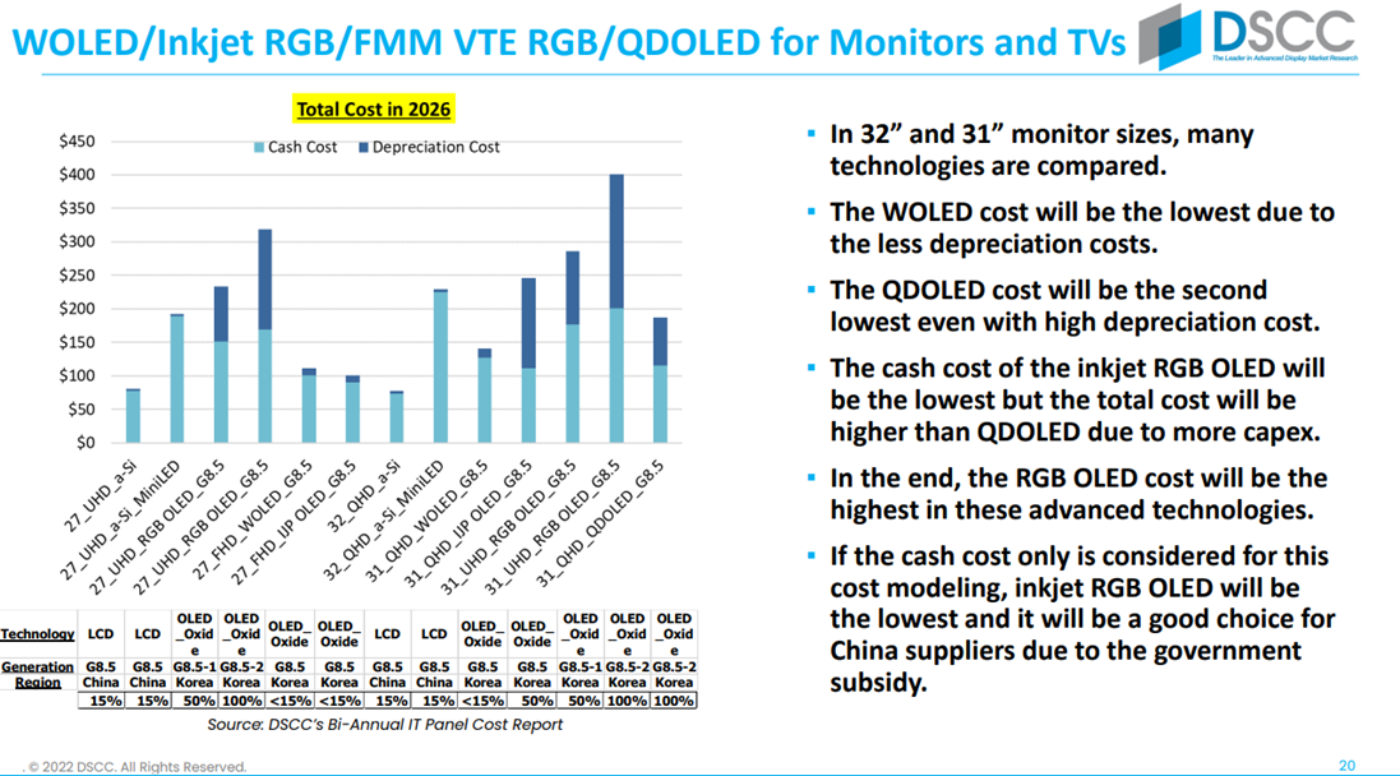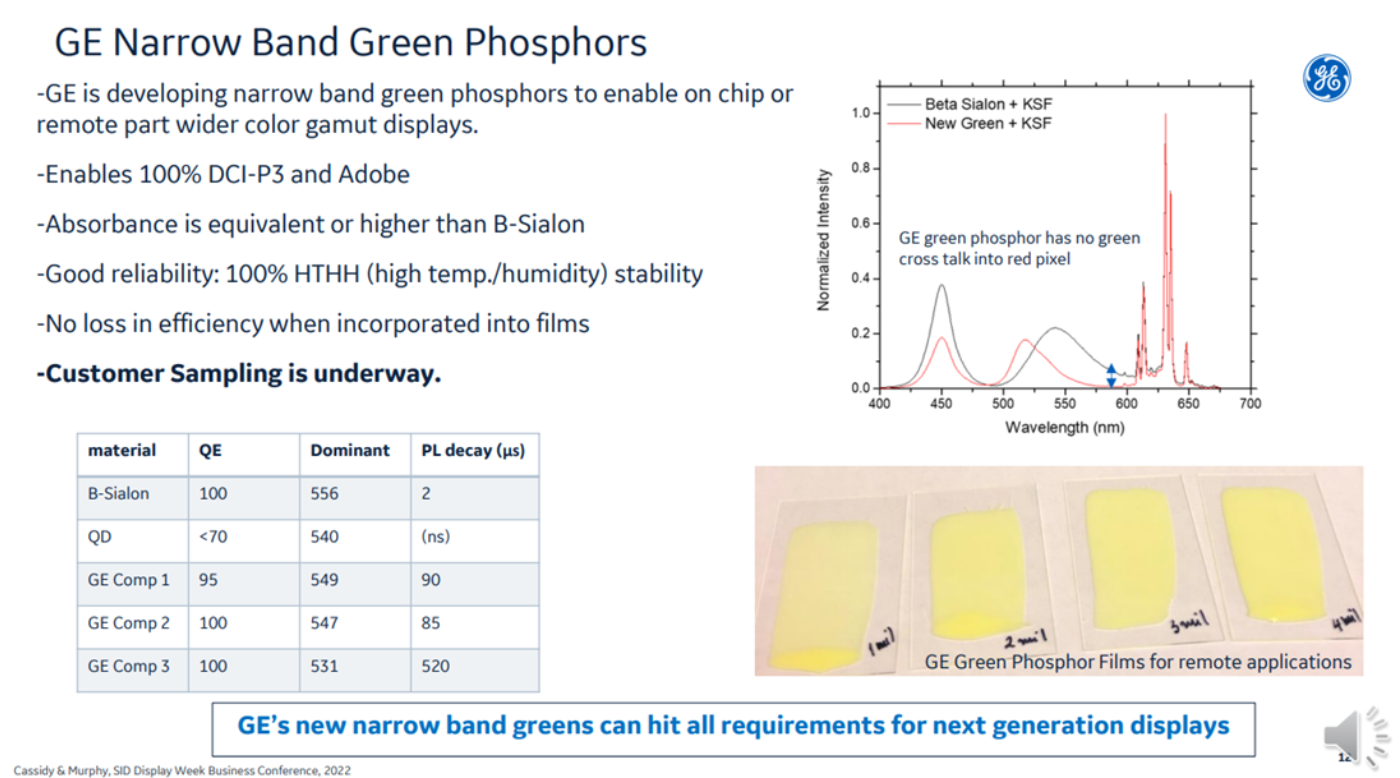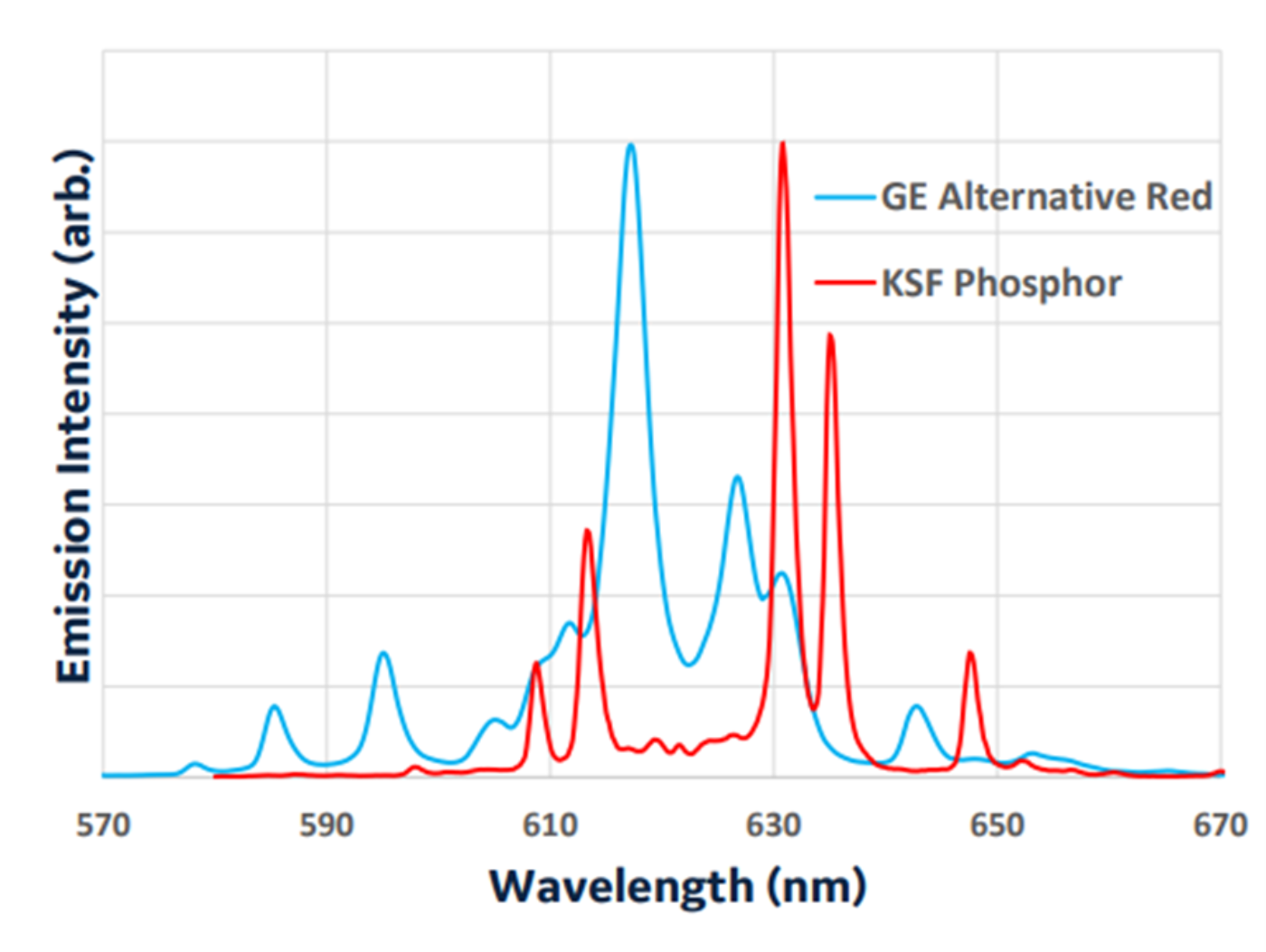SID/DSCC 2022ハイライト~新興技術が実現するTVとITの進化
冒頭部和訳
「TV Display Market and Technology Outlook」セッションでは、FPD業界のアナリストとエグゼクティブによる6講演が行われた。
田村喜男は、DSCCが年2回発行する IT Panel Cost Report と Advanced TV Panel Cost Report の収録内容を参照しながら、IT用およびTV用FPDコストの将来の動きをテーマに講演した。講演では、以下の各種IT用およびTV用先進FPDを対象に、コストと重要な考慮事項を検討した。
•第8.5世代から第8.7世代の生産ラインで製造されたノートPC、タブレット、モニター用RGB OLED
•IT用タンデム型FPD
•ハイブリッドOLED:TFEリジッドOLED
•インクジェットRGB
•QD-OLED
•MiniLEDバックライトLCD
•ノートPC用FPD:LTPS vs. Oxide vs. a-Si LCD
•TV用FPD:WOLED vs. インクジェットRGB vs. FMM VTE RGB vs. QD-OLED
最初に、各種IT製品向け設備投資と対応する減価償却費の分析が行われた。TFTアレイとOLED工程の設備投資は、同工程のLCD生産ラインの4倍になり、それに応じて減価償却費も高くなる。一方、MiniLED製品の材料とコンポーネントのコストは、バックライトが高価なため、a-Si LCDあるいはOLED製品よりも劇的に高くなる。
その結果、IT用MiniLEDのキャッシュコストはOLEDよりも大幅に高くなるが、総コストでは互角の戦いになる。ノートPC用ではOLEDがMiniLEDよりもコスト面で有利だが、先進モニター用ではOLEDのコストがMiniLEDよりも高くなる。
以下のスライドに示すように、大型サイズ (27〜32インチ) のデスクトップモニターの競争空間には今後、さまざまなFPD技術と業界供給シナリオが存在することになる。インクジェット印刷型RGB OLEDのキャッシュコストは先進製品の中で最も低くなるが、莫大な設備投資が必要であることから、総コストはRGB OLEDの次に最も高くなる。この技術は、設備投資に対して政府から手厚い補助金を受けられる中国系FPDメーカーにとっては良い選択になるかもしれない。
SID/DSCC 2022 Business Conference Highlights - Emerging Technologies Enabling TV and IT Advances
The TV Display Market and Technology Outlook session featured six presentations from analysts and executives throughout the display industry. The presenters included:
Yoshio Tamura, DSCC
Yoshi’s presentation addressed future advanced in IT and TV display costs, drawing heavily from DSCC’s Biannual IT Panel Cost Report (一部実データ付きサンプルをお送りします) and Biannual Advanced TV Display Cost Report (一部実データ付きサンプルをお送りします). He examined the costs and key considerations for various Advanced IT and TV displays in the future including:
• Notebook PC, Tablet and Monitor RGB OLED panels produced by G8.5 to G8.7 fabs;
• Tandem for IT panels;
• Hybrid OLED: Rigid OLED with TFE encapsulation;
• Inkjet RGB;
• QD-OLED;
• MiniLED Backlight LCD;
• LTPS vs. Oxide vs. a-Si LCD for Notebook PCs;
• WOLED vs. Inkjet RGB vs. FMM VTE RGB vs. QD-OLED in TVs.
Yoshi started with an analysis of capex and the corresponding depreciation costs for various IT products. The capex for the TFT array and frontplane deposition for OLED configurations will be 4x as high as for comparable LCD fabs. Depreciation costs will be correspondingly higher. On the other hand, material and component costs for MiniLED products will be dramatically higher than for a-Si LCD or OLED products, driven by more expensive backlights.
As a result, cash costs for MiniLED IT panels will be substantially higher than OLED, but total costs are more evenly matched. While OLED will have a cost advantage over MiniLED in notebook panels, OLED costs for advanced monitor panels will be higher than MiniLED.
The competitive space in larger desktop monitors (27”-32”) will involve many different display technologies and industrial supply scenarios, as shown in the slide here. The cash cost of inkjet printed RGB OLED will be the lowest among
advanced products but the total cost will be second highest (after RGB OLED) because of the heavy capex required. That technology may be a good choice for Chinese panel makers who benefit from generous government subsidies of capex.
Dr. James Murphy and Rachel Cassidy, PhD, GE
Murphy and Cassidy outlined the latest developments in advanced phosphors for wide color gamut displays. Murphy began by describing the great success of GE’s potassium fluorosilicate (KSF or PFS) red phosphor in the marketplace.
- More than 50 billion LEDs with KSF phosphor sold for displays;
- 19 companies licensing KSF;
- 6 countries;
- 4 major display applications – TV, laptop/monitor, tablet, mobile.
There are four different structures requiring a display license for KSF: an on-chip configuration, Magenta LED, remote part configuration, and MicroLED. GE asserted that as wide color gamut continues to gain momentum and LCD remains the dominant technology in TV, narrow band phosphor outsells quantum dot, notch filter and OLED TVs combined. Murphy next outlined GE’s efforts to develop smaller grain KSF for MicroLED, showing a >10x reduction in grain size.
Murphy then provided an update of GE’s progress on narrow band green phosphors with the slide shown here. GE has three different green phosphors with high quantum efficiency, excellent color point enabling 100% of DCI-P3 and fast decay times.
For MicroLED, GE outlined six possible architectures for color converters of blue LED light, with each solution having advantages and disadvantages.
- QD film + phosphor patterned on back reflector;
- QD film + phosphor under LED lens;
- KSF + Nitride + green phosphor;
- KSF + green phosphor;
- KSF + green QD;
- KSF + red phosphor + QD part.
Finally, Cassidy finished with the first public announcement of a new GE development of a red phosphor for lighting applications. The new phosphor has a shift towards higher energy (shorter wavelength) red and a decay time which is 4x faster than KSF. The new phosphor is ideal for lighting but may also be applied in displays blended with KSF.



